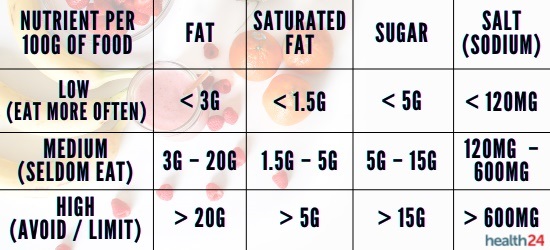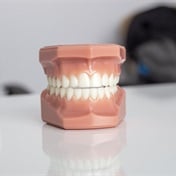- While your grocery list should largely consist of unprocessed foods, not all processed foods are bad
- Identifying which processed foods are beneficial requires learning how to decipher labels
- The three categories to guide your choices are sugars, fats and salt
Our grocery lists should largely consist of unprocessed foods such as fresh fruits, vegetables, legumes (dry beans, lentils, chickpeas) unprocessed meats (fresh chicken, beef, pork, fish) – i.e. foodstuffs that do not require a label to identify their contents.
However, not all processed food is detrimental to your health. In fact, there are several products – such as high-fibre bran flakes, canned fish and high-fibre crackers – which provide valuable nutrients.
To identify these products, it is important to understand their nutrition information labels by following the steps below – to distinguish between foods that should be frequently eaten, those that should be seldom eaten, and those that should be avoided or severely limited.
STEP 1: Start with the nutrition table
The main nutrients on the label to look out for are sugar, total fat, saturated fat, trans-fat and sodium or salt.
Sugars and fats can lead to an energy surplus, which may cause weight gain.
Saturated and trans-fats and salt can contribute to an increased risk of high blood pressure and heart disease.
To assess products, we should check the nutrient contents per 100g.
Products that can be consumed frequently are those that contain less than 3g fat, less than 1,5g saturated fat, less than 5g sugar and less than 120mg sodium per 100g.
Products that should be consumed seldom are those that fall between 3–20g fat, 1.5–5g saturated fat, 5–15g sugar and 120–600mg of sodium per 100g.
Lastly, products that should be avoided are those that contain more than 20g fat, more than 5g saturated fat, more than 15g sugar and more than 600mg sodium per 100g.
The table below displays a summary of important nutrients.
It is important to remember that if one of the four listed nutrients falls into a higher category, the entire item falls into that category.
For example, in a bag of jellybeans, the fat, saturated fat, and sodium are less than 3g, less than 1.5g and less than 120mg respectively, but the sugar content is 75g per 100g – therefore, the product is in the "high" or "avoid" category.
We should, however, not only look at the ingredients that should be avoided, but also those that should be incorporated into our diet.
Fibre is important for optimal gut health. It is recommended to aim for more than 6g per 100g.
Why do we not use the serving size to determine the quality of a food?
Firstly, it makes it difficult to cross-compare foods and, secondly, the serving size might not be the right portion for you to consume.
Comparing products using the “per 100g” nutrient panel makes it easier to effectively compare different products.
STEP 2: Check the list of ingredients
The ingredients are always listed in descending order, according to weight.
This means that the most prevalent ingredient will be listed first, followed by the second most dominant ingredient, and so on.
It is recommended to look at the first three ingredients to get a sense of what the product is mainly made up of.
This is, however, not always that straightforward, as ingredients are often disguised by using other names.
Here are some common ingredients to look out for:
Sugar can also be identified as: brown sugar, concentrated fruit juice, corn syrup, dextrose, treacle, fructose, glucose, glucose syrup, golden syrup, honey, invert sugar, lactose, malt, malt extract, maltose, isomaltose, maltodextrin, maple syrup, molasses, raw sugar, sucrose and cane sugar.
Fats can be identified by the following names: animal fat, beef fat, butter, chocolate, carob, coconut oil, cream, dripping, ghee, hydrogenated oils, lard, margarine, milk solids, monoglycerides, palm oil, seeds, nuts, coconut, tallow, shortening, trans fats and vegetable fat.
Sodium is present in the following ingredients: baking soda, monosodium glutamate (MSG) and any word containing the terms sodium, nitrate and nitrite.
To conclude: By following these two simple steps, you will be more informed and confident in your ability to select the best products for your health.
READ | A dietitian explains how to read food labels
READ | What you might be getting wrong about probiotics - and how fibre fits into the picture




 Publications
Publications
 Partners
Partners

















